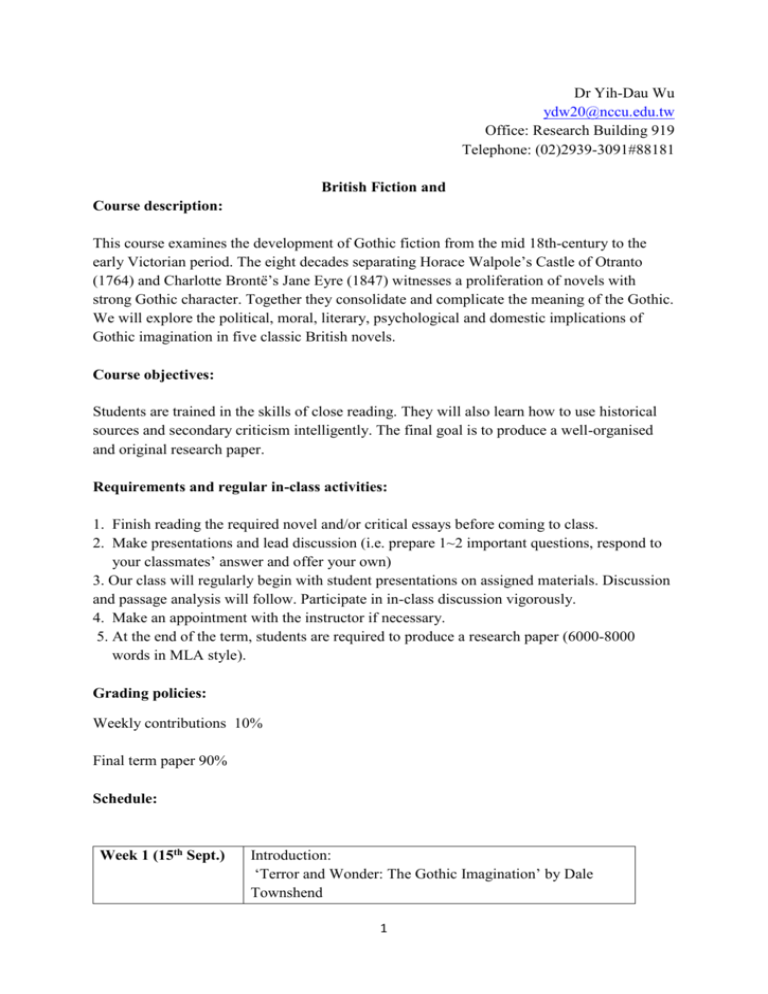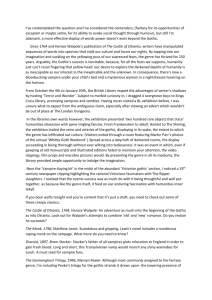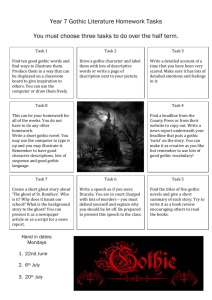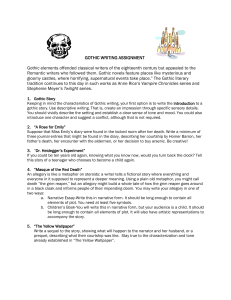Gothic fiction syllabus
advertisement

Dr Yih-Dau Wu ydw20@nccu.edu.tw Office: Research Building 919 Telephone: (02)2939-3091#88181 British Fiction and Course description: This course examines the development of Gothic fiction from the mid 18th-century to the early Victorian period. The eight decades separating Horace Walpole’s Castle of Otranto (1764) and Charlotte Brontё’s Jane Eyre (1847) witnesses a proliferation of novels with strong Gothic character. Together they consolidate and complicate the meaning of the Gothic. We will explore the political, moral, literary, psychological and domestic implications of Gothic imagination in five classic British novels. Course objectives: Students are trained in the skills of close reading. They will also learn how to use historical sources and secondary criticism intelligently. The final goal is to produce a well-organised and original research paper. Requirements and regular in-class activities: 1. Finish reading the required novel and/or critical essays before coming to class. 2. Make presentations and lead discussion (i.e. prepare 1~2 important questions, respond to your classmates’ answer and offer your own) 3. Our class will regularly begin with student presentations on assigned materials. Discussion and passage analysis will follow. Participate in in-class discussion vigorously. 4. Make an appointment with the instructor if necessary. 5. At the end of the term, students are required to produce a research paper (6000-8000 words in MLA style). Grading policies: Weekly contributions 10% Final term paper 90% Schedule: Week 1 (15th Sept.) Introduction: ‘Terror and Wonder: The Gothic Imagination’ by Dale Townshend 1 Week 3 (29th Sept.) ‘Gothic Enlightenment/ Enlightenment Gothic’ by Carol Davison ‘Gothic fiction [in the Romantic period]’ by Deidre Lynch Week 4 (6th Oct.) The Castle of Otranto Week 5 (13th Oct.) The Castle of Otranto; ‘Sexual Violence and Woman’s Place: The Castle of Otranto’ by Valdine Clemens The Castle of Otranto; ‘Frenzy: The Castle of Otranto’ by Elizabeth Napier The Monk The Monk; ‘Public Censorship and Personal Repression: The Monk’ by Clemens The Monk; ‘Social Hierarchy in Matthew Lewis’s The Monk’ by Daniel Watkins Week 2 (22nd Sept.) Week 6 (20th Oct.) Week 7 ( 27th Oct.) Week 8 (3rd Nov.) Week 9 (10th Nov.) Week 10 (17th Nov.) Week 11(24th Nov.) Week 12(1st Dec.) The Italian The Italian; ‘Villainy: The Italian’ by Napier The Italian; ‘Sensibility Restored’ by Sydney Conger Week 13(8th Dec.) Week 14 (15th Dec.) Frankenstein Frankenstein; ‘Frankenstein and the Unnameable’ by George Haggerty Week 15 (22nd Dec.) Frankenstein; ‘Frankenstein’s Queer Gothic’ by Mair Rigby Week 16 (29th Dec.) Week 17 (5th Jan.) Jane Eyre Jane Eyre; ‘Charlotte Brontë’s New Gothic’ by Robert Heilman Jane Eyre; ‘Gothic Romance and Women’s Reality in Jane Eyre’ by Eugenia DeLamotte; Term paper due. Week 18 (12th Jan.) Bibliography Botting, Fred. Gothic. London: Routledge, 1996. Clery, E. J. The Rise of Supernatural Fiction 1762-1800. Cambridge: Cambridge UP, 1995. ---. Women’s Gothic: From Clara Reeve to Mary Shelley. Tavistock: Northcote House, 2000. Duncan, Ian. Modern Romance and the Transformation of the Novel: The Gothic, Scott, Dickens. Cambridge: Cambridge UP, 1992. Ellis, Markman. The History of Gothic Fiction. Edinburgh: Edinburgh UP, 2000. Gamer, Michael. Romanticism and the Gothic. Cambridge: Cambridge UP, 2000. Howard, Jacqueline. Reading Gothic Fiction: A Bakhtinian Approach. Oxford: Clarendon Press, 1994. Kilgour, Maggie. The Rise of the Gothic Novel. London: Routledge, 1995. 2 Mighall, Robert. A Geography of Victorian Gothic Fiction: Mapping History’s Nightmares. Oxford: Oxford UP, 1999. Punter, David. The Literature of Terror: A History of Gothic Fictions from 1765 to the Present. London: Longman, 1980. Walpole, Horace. The Castle of Otranto. Ed. E. J. Clery. Oxford: Oxford UP, 1996. Watt, James. Contesting the Gothic: Fiction, Genre and Cultural Conflict 1764-1832. Cambridge: Cambridge UP, 1999. 3







